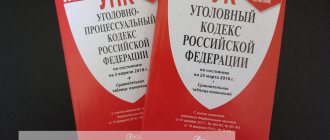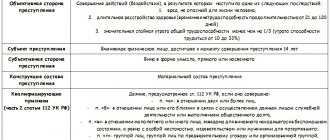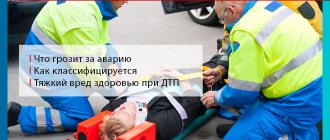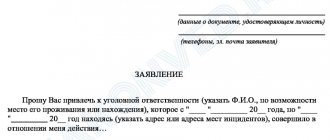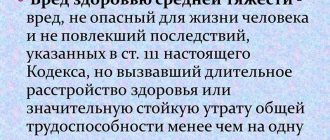Causing harm to health of moderate severity is punishable by criminal law, even if the victim suffered minor harm.
The legislation provides for the use of several options for influencing the offender, including arrest for a certain period.
The seriousness of legal measures depends on several factors, which are clarified by the investigation.
What health hazards are classified as moderate?
Regardless of the reasons why harm to a person’s health occurred (beating, poisoning, accident, work injury, etc.), the degree of its severity is determined taking into account the Medical criteria approved by Order of the Ministry of Health of April 24, 2008 No. 194n.
Harm to health will be a violation of the anatomical integrity and physiological functions of organs or tissues of the human body by any external influences.
Depending on the signs, which are called qualifying, only 3 degrees of severity of harm to health are determined:
- Slight harm to health.
- Moderate harm to health.
- Serious harm to health.
Moderate harm to human health meets the following criteria:
- It does not pose a threat to the victim's life.
- Did not cause loss of speech, hearing, vision, organ, inability to function, mental illness, termination of pregnancy, drug addiction/substance abuse, permanent facial disfigurement, loss of ability to work more than a third or the full extent of professional ability. These consequences are not life-threatening, but by their nature they significantly affect the quality of future life.
- Causes health problems and incapacity for work lasting 21 days or more. In this case, it is calculated in days during which the restriction took place and did not undergo treatment, since sometimes these periods do not coincide. That is, for this characteristic, specific injuries and damages are not defined; only the condition for classifying them as moderate severity is indicated - the duration of temporary disability is more than 3 weeks.
- Caused the loss of 10-30% of total working capacity. It consists in the loss of functions (for example, caring for oneself), loss of skills, and the ability to carry out work. The percentage of such loss is determined in accordance with the table - Appendix to the above-mentioned order.
Injuries causing moderate harm
Any injuries and damages that meet the above requirements can result in moderate harm. This takes into account not only the injuries themselves, but also their consequences, which may vary depending on the specific person who received them, his state of health, age and many other factors.
Often in practice (from verdicts) experts regard the following as having caused moderate harm to health:
- closed simple fractures of bones without displacement (nose, jaw, cheekbone, ribs, arm bones, legs and others);
- cracked ribs;
- dislocations;
- closed head injuries without serious consequences;
- injuries resulting in a narrowing of the field of vision, a decrease in its acuity, decreased hearing or deafness in one ear;
- loss of 4 or more teeth, one finger or part thereof;
- various soft tissue wounds and many others.
Who determines harm to health
The severity of the injuries received by the victim is determined exclusively by forensic medical examination.
The expert conducting the examination (doctor) to determine the severity of harm to health can be either an employee of a medical institution or an individual entrepreneur. The requirements for him are the presence of special knowledge, a license for medical activities, including for conducting examinations.
The same criteria and rules apply for conducting expert research, regardless of the purpose of their conduct and further use. Expert conclusions can be used in civil (in claims for damages), administrative (in cases of offenses) and criminal (in criminal cases) proceedings.
Various objects can be studied during the examination:
- the victim himself;
- materials of the case for which the examination was initiated;
- original medical documents with comprehensive information about injuries and their clinical course;
- If necessary, other documents and information are studied.
The General Rules by which such studies are carried out are approved by the Government of the Russian Federation (Resolution No. 522 of August 17, 2007).
Criminal liability for moderate harm to health
The Criminal Code of Russia has several norms in which the consequences in the form of harm to the victim’s health, qualified as moderate severity, are directly named as a mandatory feature for bringing to responsibility. This is Art. 112, 113 and 114.
Art. 112 of the Criminal Code of the Russian Federation
This provision provides for punishment for intentional actions and inactions that caused moderate harm to the health of the victim of a crime.
Details: Art. 112 of the Criminal Code of the Russian Federation. Intentional infliction of moderate harm to health
This can be such active actions as beating with hands, feet, objects, causing injuries, wounds, cuts, burns, sections, poisoning, as well as creating conditions in which the victim will inevitably receive damage, etc.
Considering that the ability to realize the value and inviolability of another person’s health should be formed at an early age, the legislator established liability for this crime from the age of 14.
The maximum punishment under Art. 112 is provided for causing damage with qualifying criteria (when there are 2 or more victims, committed by a group of people, for hooligan reasons, etc. (Part 2)) - up to 5 years of complete isolation from society in prison. If these signs are not present in the act (Part 1), the most severe punishment is 3 years in prison.
Investigation of criminal cases under Art. 112 of the Criminal Code of the Russian Federation is being investigated by investigators from the Ministry of Internal Affairs.
Art. 113 of the Criminal Code of the Russian Federation
Under this article, causing moderate harm to health is punishable if the perpetrator was in a special mental state at the time of the commission, called a state of passion .
Affect is a sudden strong emotional disturbance, as a result of which a person momentarily loses control over his actions and cannot direct them.
In Art. 113 provides an exhaustive list of the reasons why this condition is caused. These reasons relate to the behavior of the victim and provoke the perpetrator to a kind of protection from the negative actions of the victim. The cause of passion for the onset of liability under Art. 113 may include the following actions:
- Violence on the part of the victim towards the perpetrator - beatings, beatings, wounds, sections, injections, burns, mental violence, etc.
- Bullying - physical or mental. These are violent or insulting actions against the perpetrator, characterized by cynicism.
- A grave insult is a cruel, gross humiliation of the dignity of the perpetrator by word, action, etc.
- Other unlawful or contrary to morality, immoral behavior of the victim.
- A psychotraumatic situation that lasts for a significant period of time, resulting from such behavior of the victim. It can develop due to long-term, systematically occurring quarrels, conflicts, bullying and violence against the perpetrator.
The punishment for this crime compared to the sanction of Art. 112 of the Criminal Code of the Russian Federation is a little softer, the most severe is up to 2 years in prison. Prosecution is possible from the age of 16.
Within the same limits, similar actions are punishable, but with consequences for the victim in the form of serious harm to his health.
Criminal cases are investigated under Art. 113 of the Criminal Code of the Russian Federation, investigators of the Ministry of Internal Affairs.
Art. 114 of the Criminal Code of the Russian Federation
This article consists of 2 parts, each of which punishes the infliction of moderate harm to the health of the victim, committed in special conditions that also deserve mitigation of punishment:
- When the limits of necessary defense are exceeded (part 1). The limits of such protection are described in Art. 37 of the Criminal Code of the Russian Federation. The basis for recognizing it as adequate to the actions of the attacker is the reality of the possibility of causing harm dangerous to the health and life of any person, not only the one defending himself. The most severe punishment for causing moderate harm to the health of a person from whom the perpetrator was defending himself is up to a year in prison.
- If the measures necessary to apprehend a criminal are exceeded (part 2). It is understood as their obvious discrepancy between the danger of the detained person and the crime committed by him, when, based on the circumstances, clearly excessive harm is caused to him (Article 38 of the Criminal Code of the Russian Federation). The most severe punishment is up to 2 years in prison.
The same article punishes actions that cause grievous harm. Responsibility begins at age 16. Investigators from the Ministry of Internal Affairs are also investigating the cases.
Average harm to health in other articles of the Criminal Code
In some norms of the Criminal Code, harm to the health of the victim of moderate severity is indicated as a necessary consequence of illegal actions on the part of the perpetrator for liability to occur.
However, there are other articles where such consequences are not mandatory, but are a sign of toughening the punishment. Based on the definition of average severity of harm to health, it is included in the qualifying feature “with the use of violence that is not dangerous to life and health” or “with the use of violence” (any, including causing harm to health of moderate severity).
Among the most common is, for example, robbery under paragraph “g” of Part 2 of Art. 161, theft under paragraph “c” of Part 2 of Art. 166, extortion under paragraph “c” of Part 2 of Art. 163 of the Criminal Code of the Russian Federation.
Careless infliction of average bodily harm
There is no provision for criminal liability for actions or inactions that cause harm to another person, which is regarded as moderate, committed through negligence.
Previously, before the adoption of Federal Law No. 162-FZ of December 8, 2003, such actions were punishable under Art. 118 of the Criminal Code of the Russian Federation. This law introduced changes to the article, in connection with which liability for careless infliction of harm of moderate severity was excluded. Currently, only careless infliction of grievous bodily harm is prosecuted under this article.
Similarly, there is no criminal liability for moderate harm caused to the health of the victim as a result of an accident. It can only occur if the incident has consequences for the victim in the form of serious harm to his health (Part 1 of Article 264 of the Criminal Code of the Russian Federation).
Liability for average damage as a result of an accident
The absence of criminal liability for causing moderate harm to the health of a victim in an accident due to the violation of the Traffic Rules by the perpetrator does not mean that such an act is not prosecuted at all; it is punishable under Part 2 of Art. 12.24 Code of Administrative Offenses of the Russian Federation.
The process of conducting an investigation into such facts, bringing them to justice, and considering cases is significantly different from the criminal process. The punishment for such an offense may be a fine of 10 thousand to 25 thousand rubles, the alternative is deprivation of a driver’s license for a period of 1.5 to 2 years.
Arbitrage practice
Let's look at a few examples of moderate harm to health.
Example No. 1. A dispute ensued between citizen K. and citizen D. During the altercation, citizen D. attacked citizen K. During the fight, citizen D. punched citizen K. several times in the face and in the chest area. After the fight, citizen K. had a broken nose and rib. The court qualified the actions of citizen D. under Part 1 of Article 112 of the Criminal Code of the Russian Federation and imposed a sentence of forced labor for 6 months.
Example No. 2. Citizen M. and citizen S., by prior conspiracy, attacked citizen E. when she was returning home from work. Citizen M. punched Citizen E. twice in the stomach and several punches in the face. Citizen S. struck Citizen E. on the head with a blunt object. During this incident, citizen E. broke her arm, received numerous bruises on her body, and also received a slight concussion after a blow to the head. The crime was classified under Part 2 of Article 112 of the Criminal Code of the Russian Federation. The court sentenced citizen M. to imprisonment for a period of 2 years, and citizen S. to imprisonment for 1.5 years.
Compensation for moderate health damage
The manner and process for adjudicating personal injury claims differs significantly between criminal and civil proceedings. What is common is that in such cases two types of damage can be compensated – property and moral.
Material damage
Material, or property, damage may consist of:
- earnings that the victim received less due to incapacity for work;
- expenses for treatment, additional food, care, medicines, rehabilitation means, a sanatorium, if the victim needs them, they were paid for and were not provided free of charge.
This type of harm is compensated based on the data from the relevant medical and payment documents.
Moral injury
The rights to personal integrity and health are classified by law as personal non-property rights, and therefore their violation provides the victim with the right to compensation for moral damage caused by damage to health.
Moral damage is suffering caused by pain, the consequences of injuries, wounds, other damage, and their impact on the life of the victim and the life of his family.
The decision on the amount of material compensation according to the rules of Art. 151 of the Civil Code of the Russian Federation is decided by the court, based on the facts found out at the court hearing - the degree of guilt of the criminal, his lifestyle, the suffering of the victim, taking into account his individual characteristics, and others.
There is no specific amount or limit established by law. The victim determines it himself, but the decision on the final amount is made by the court based on the results of an examination of relevant circumstances and documents.
The procedure for recovery in criminal proceedings
The process of compensation for harm caused is the same for all criminal cases, including those involving damage to the victim that resulted in moderate harm to his health. The only difference is the possibility of compensation for moral damage, which may not be available in other cases.
Article 44 of the Code of Criminal Procedure of the Russian Federation directly states that a person who has suffered from a crime has the right to file a civil claim for compensation for material damage and compensation in property or monetary terms for the suffering suffered (moral damage). This also applies to all cases of causing moderate harm to the victim’s health.
Filing claims for damages
A civil claim in a criminal proceeding may be filed from the moment the case is initiated until the end of the judicial investigation stage. There are no strict requirements for its form or content, as when filing a claim in civil proceedings.
It is addressed to the investigator, inquiry officer, or court, and must contain a request for recognition as a civil plaintiff. recognize him as a civil plaintiff (recognition is formalized by a resolution). Together with the confession, the victim acquires all his rights and obligations (Part 4 of Article 44 of the Code of Criminal Procedure of the Russian Federation).
You can abandon the claim until the moment when the court retires to the deliberation room to make a final decision on the case.
The undoubted advantages in this case are:
- There is no obligation to pay the state fee for the statement of claim (Part 2 of Article 44 of the Code of Criminal Procedure of the Russian Federation).
- Absence of complex requirements for the form and content of the claim, its justification.
- The responsibility to establish the nature and extent of the harm caused by the crime (Article 73 of the Code of Criminal Procedure of the Russian Federation) lies with the person who is investigating the criminal case (investigator/inquirer). This does not deprive the victim of the right to present evidence to substantiate the extent of the harm.
- Simultaneous consideration of the claim and the criminal case itself, or a separate statement of claim in civil proceedings, is not necessary.
Possible court decisions on the claim
Based on the results of consideration of the claim, the court may make one of the following decisions:
- Satisfy it partially or fully (if the right to compensation and its amount are proven and justified).
- Refuse satisfaction (for example, if the damage is not subject to compensation, or if the person is acquitted);
- Recognize the plaintiff's right to satisfy the claim, while transferring consideration of the amount of compensation through civil proceedings. In this case, you will have to file a claim according to the requirements of civil law.
Amount of compensation for damage
The amounts that can be recovered from the perpetrator of causing moderate bodily injury in favor of the victim are completely different . The courts rely on practice, including that developed in the region. Moral damage, for example, can reach 500 thousand rubles. And, of course, intentional harm caused as a result of a crime under Art. 112, should be assessed higher than under Art. 113 and 114 of the Criminal Code of the Russian Federation.
The nature and extent of the harm must be established during the proceedings (clause 4, part 1, article 73 of the Code of Criminal Procedure of the Russian Federation). The amount of damage, both property and moral, must be confirmed by relevant documents, checks, witness statements, etc. Property damage is compensated for a confirmed and justified amount. Moral - in the amount that the court considers adequate to the suffering that resulted from the crime.
Compensation for harm outside of criminal proceedings
In all other cases of injury to another person, which is regarded as harm to health of moderate severity, exclusively the provisions of civil law are applied to compensate for moral and material damage.
The possibility of filing a claim in the course of proceedings in cases of administrative offenses, including in cases of moderate harm to health in an accident under Art. 12.24 of the Code of Administrative Offenses of the Russian Federation, not provided for by law.
Therefore, in order for a decision to be made to recover money from the person who caused such harm to compensate for it, it is necessary to independently file a corresponding statement of claim with the court.
For property damage, the provisions of Chapter 59 of the Civil Code of the Russian Federation apply, for moral damage - Art. 151 Civil Code.
To prove these versions, the defense chose the following tactics:
Establishment of individual psychological characteristics of personality and physical data.
From Ivan’s testimony it followed:
“that he was struck in the head. From this blow, Ivan hit the back of his head on the car body near the roof. After the blow he received, his perception was scattered, everything went dark in his eyes, he was in a state of prostration.”
Further, as part of the lawyer's survey, the following were interviewed: Ivan's wife, his former boss and current boss.
Ivan’s wife explained:
“that her husband is a calm, not hot-tempered person, reasonable by nature, avoids conflicts.”
From the explanations of Ivan’s former boss it follows:
“He knows Ivan as a kind, sympathetic, non-conflict person. He never saw Ivan in an angry, malicious state.”
From the explanations of the current boss, Ivan, it followed:
“Ivan is a very calm, balanced person; he does not tend to conflict, humiliate, or laugh at anyone. Ivan always thinks about his actions for the future, before doing anything, he thinks many times about the possible consequences, and makes sure that his decision is correct.”
By occupation, Ivan was a programmer. According to medical documents included in the case file, Ivan had a number of chronic diseases that did not allow him to be in good physical shape. Ivan’s physique is thin; Ivan has never been involved in combat sports or martial arts.
Through a lawyer's request, it was established that the man who struck Ivan had a military education. According to anthropometric data, he was taller than Ivan and larger in build, weight, and build.
Thanks to the establishment of the individual psychological characteristics of Ivan’s personality and physical data, comparing them with the anthropometric data of the man who hit him, taking into account his military education and special training, it was possible to conclude that in the situation that occurred, Ivan could hardly initiate a conflict with the person who is physically much stronger and older than him.
Application for a forensic psychological and psychiatric examination.
The reason for prescribing a forensic psychological and psychiatric examination is the behavior of the suspect/accused when committing the incriminated act: unexpectedness of actions, the appearance of previously unusual forms of behavior, as well as data on the conflict situation before the event.
The purpose of the examination is to establish in the suspect/accused the presence or absence of a temporary mental disorder (the competence of a psychiatrist-expert), physiological affect (a normal, but extremely strong emotional reaction) or other emotional states (the competence of a psychological expert) at the time of the commission of the incriminated act.
In order to establish these circumstances in relation to Ivan, it became necessary to conduct a comprehensive outpatient psychological and psychiatric examination in order to obtain answers to the following questions:
Was Ivan in a state of passion at the time of committing the act accused of him?
What is Ivan’s general psychological characteristics (temperament, character, inclinations, needs)?
What are Ivan’s individual psychological characteristics (characterological, emotional-volitional)? Did they have a significant influence on his behavior during the commission of the act charged with him?
Was Ivan, at the time of committing the act accused of him, in a state of heightened emotional tension caused by a traumatic situation?
Considering Ivan’s mental state, his individual psychological characteristics, as well as the circumstances of the case, could he accurately correlate his defensive actions with the objective requirements of the situation?
Conducting a psychophysiological study (polygraph test), filing a request for questioning of a polygraph examiner.
The use of a polygraph (lie detector) in the process of evidence in criminal cases is highly controversial. As a general rule, the conclusion based on the results of a polygraph test is not accepted as evidence in a criminal case, however, the opposite practice also exists. At the same time, one of the ways to legalize a polygraph conclusion is to interrogate the person who conducted the specified study as a specialist. In combination with a polygraph conclusion and an interrogation of a polygraph examiner, the chances that this conclusion will be taken into account increase. In addition, it is worth considering that even if the polygraph report is not regarded as evidence in the case, in any case it contains indicative information that may be valuable in the absence of other evidence.
In the case under consideration, the use of a polygraph was due to the fact that Ivan’s testimony and the testimony of the man who was injured were significantly different, and there was no other evidence with which to eliminate the contradictions.
As a result of the psychophysiological study, it was found that Ivan’s reactions to the questions asked were consistent with his answers about the events of bodily harm. Thus, it was established that Ivan’s testimony regarding the circumstances of the event was truthful. The conclusion of the psychophysiological study was added to the materials of the criminal case.
In order to establish the circumstances of the psychophysiological study, clarify the methods, equipment used by the specialist, the validity of the study and the conclusion reached, a request was made to interrogate the person who conducted the study as a specialist. In addition, a request was made to conduct a psychophysiological examination of the victim in order to establish the veracity of his testimony.
Application for a medical-forensic (situational) forensic examination.
During the investigation of the criminal case, two versions of the event were identified in terms of causing damage (the suspect's version and the victim's version). The versions presented by the suspect and the victim had contradictions in the following points:
The victim claimed that Ivan struck him first, only after that the victim hit Ivan in the face area. Ivan sets out a different sequence, and indicates that the infliction of damage with a knife occurred after a blow to his face, while the infliction of damage with a knife was unintentional, and became possible only as a result of the fact that the victim grabbed him with his hands in the chest area and tried to maintain balance Ivan grabbed the victim’s shoulders, thereby accidentally cutting his body in the neck area.
The victim claims that when he and Ivan took hold of the clothes, they moved around. Ivan claims that he did not grab the victim’s clothes and they stood still.
The victim claims that when he and Ivan grabbed each other’s clothes, they pushed each other and tried to throw each other to the ground. Ivan indicates that these actions did not occur, that he did not push or try to throw the victim to the ground.
Considering that the mechanism of formation of the injuries present to the victim is essential for the investigation of a criminal case, taking into account that the version presented by the suspect must be verified, the need arose to conduct a medical-forensic (situational) forensic examination, during which, with the participation of It is possible for a forensic physician to recreate the situation of the event and check the possibility of causing damage to the victim based on the version stated by the suspect, namely, to obtain answers to the following questions:
What is the mechanism of formation and localization of the injuries the victim has?
Could the injuries present to the victim have occurred under the circumstances stated by the suspect?
What is the mechanism of formation and localization of the damage present on the suspect?
Could the suspect’s injuries (contusion of the soft tissues of the face on the left in the projection of the cheekbone and bruise of the soft tissues of the occipital part of the head) occur under the circumstances described by the suspect?
Some advice from a lawyer
In some situations, a forensic expert will not be able to qualify the harm caused to the victim’s health as a result of criminal actions.
In particular, this is possible in the absence of medical documents or insufficient or incomplete information about the damage itself, methods and results of treatment reflected in them.
Therefore, if a person nevertheless becomes a victim of a beating, receives injuries, damage, in order to exclude this possibility, in order to fix them, it is necessary to seek medical help immediately, do not ignore the doctor’s prescriptions and follow the recommendations. It is also important not to hide and describe the injuries as fully as possible, and also try to ensure that doctors reflect them in the documentation.
If you still have to apply for compensation through civil proceedings, you should not neglect qualified legal assistance. It will not be superfluous in criminal proceedings for both the alleged criminal and his victim.
Victim's version:
The victim did not agree with the circumstances of the incident as stated by the suspect. The victim indicated that when he approached the car, Ivan got out of it, he began to talk to him, during the conversation the victim approached Ivan, after which they grabbed each other’s clothes, pushed, struggled, moved around, then the victim felt pain in the back area, and in response he punched Ivan in the face. Moving away from Ivan, the victim saw that he had a cut in the neck area. The victim indicated that he did not strike Ivan first; he struck only after Ivan cut him with a knife.
